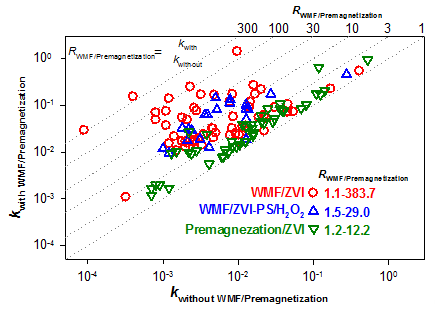| [1] Gould, J. P. Water Res. 1982, 16, 871.
[2] Khudenko, B. M. Water Sci. Technol. 1985, 15, 204.
[3] Gillham, R. W.; O'Hannesin, S. F. Ground Water 1994, 32, 958.
[4] Matheson, L. J.; Tratnyek, P. G. Environ. Sci. Technol. 1994, 28, 2045.
[5] EPA, USA, Ground Water Remedies Selected at Superfund Sites, 2002.
[6] Guan, X. H.; Sun, Y. K.; Qin, H. J.; Li, J. X.; Lo, I. M.; He, D.; Dong, H. R. Water Res. 2015, 75, 224.
[7] Wang, C.; Zhang, W. Environ. Sci. Technol. 1997, 94, 9602.
[8] Hung, H. M.; Hoffmann, M. R. Environ. Sci. Technol. 1998, 32, 3011.
[9] Lien, H. L.; Zhang, W. X. J. Environ. Eng. 1999, 125, 1042.
[10] Harendra, S.; Vipulanandan, C. Colloid Surface A 2008, 322, 6.
[11] Liou, Y. H.; Lo, S. L.; Lin, C. J.; Wen, H. K.; Weng, S. C. J. Hazard. Mater. 2005, 126, 189.
[12] Son, H. S.; Im, J. K.; Zoh, K. D. Water Res. 2009, 43, 1457.
[13] Jou, C. J. G.; Hsieh, S. C.; Lee, C. L.; Lin, C.; Huang, H. W. J. Taiwan Inst. Chem. E 2010, 41, 216.
[14] Xu, J.; Hao, Z.; Xie, C.; Lv, X.; Yang, Y.; Xu, X. Desalination 2012, 284, 9.
[15] Huang, Y. H.; Tang, C.; Zeng, H. Chem. Eng. J. 2012, 200, 257.
[16] Scherer, M. M.; Johnson, K. M.; Westall, J. C.; Tratnyek, P. G. Environ. Sci. Technol. 2001, 35, 2804.
[17] Noubactep, C. Environ. Technol. 2008, 29, 909.
[18] Kim, D. H. J. Hazard. Mater. 2011, 192, 928.
[19] Jiang, J. H.; Li, Y. H.; Cai, W. M. J. Hazard. Mater. 2008, 153, 508.
[20] Ambashta, R. D.; Repo, E.; Sillanpää, M. Ind. Eng. Chem. Res. 2011, 50, 11771.
[21] Liang, L.; Sun, W.; Guan, X.; Huang, Y.; Choi, W.; Bao, H.; Li, L.; Jiang, Z. Water Res. 2014, 49, 371.
[22] Liang, L.; Guan, X.; Huang, Y.; Ma, J.; Sun, X.; Qiao, J.; Zhou, G. Sep. Purif. Technol. 2015, 156, Part 3, 1064.
[23] Sun, Y. K.; Guan, X. H.; Wang, J. M.; Meng, X. G.; Xu, C. H.; Zhou, G. M. Environ. Sci. Technol. 2014, 48, 6850.
[24] Guan, X.; Jiang, X.; Qiao, J.; Zhou, G. J. Hazard. Mater. 2015, 300, 688.
[25] Jiang, X.; Qiao, J.; Lo, I. M. C.; Wang, L.; Guan, X.; Lu, Z.; Zhou, G.; Xu, C. J. Hazard. Mater. 2015, 283, 880.
[26] Feng, P.; Guan, X. H.; Sun, Y. K.; Choi, W. Y.; Qin, H. J.; Wang, J. M.; Qiao, J. L.; Li, L. N. J. Environ. Sci.-China 2015, 31, 175.
[27] Li, J.; Bao, H.; Xiong, X.; Sun, Y.; Guan, X. Sep. Purif. Technol. 2015, 151, 276.
[28] Xu, C.; Zhang, B.; Zhu, L.; Lin, S.; Sun, X.; Jiang, Z.; Tratnyek, P. G. Environ. Sci. Technol. 2016, 50, 1483.
[29] Liang, L. P.; Guan, X. H.; Shi, Z.; Li, J. L.; Wu, Y. N.; Tratnyek, P. G. Environ. Sci. Technol. 2014, 48, 6326.
[30] Xu, H.; Sun, Y.; Li, J.; Li, F.; Guan, X. Environ. Sci. Technol. 2016, 50, 8214.
[31] Xiong, X.; Sun, Y.; Sun, B.; Song, W.; Sun, J.; Gao, N.; Qiao, J.; Guan, X. RSC Adv. 2015, 5, 13357.
[32] Xiang, W.; Zhang, B.; Zhou, T.; Wu, X.; Mao, J. Sci. Rep.-UK 2016, 6.
[33] Xiong, X.; Bo, S.; Jing, Z.; Gao, N.; Shen, J.; Li, J.; Guan, X. Water Res. 2014, 62, 53.
[34] Ragsdale, S. R.; Grant, K. M.; White, H. S. J. Am. Chem. Soc. 1998, 120, 13461.
[35] Hinds, G.; Coey, J.; Lyons, M. E. G. Electrochem. Commun. 2001, 3, 215.
[36] Lioubashevski, O.; Katz, E.; Willner, I. J. Phy. Chem. B 2004, 108, 5778.
[37] Waskaas, M.; Kharkats, Y. I. J. Electroanal. Chem. 2001, 502, 51.
[38] Li, J.; Qin, H.; Zhang, W.-X.; Shi, Z.; Zhao, D.; Guan, X. Sep. Purif. Technol. 2016, 176, 40.
[39] Aziz, F.; Pandey, P.; Chandra, M.; Khare, A.; Rana, D. S.; Mavani, K. R. J. Magn. Magn. Mater. 2014, 356, 98.
[40] Ghosh, N.; Mandal, B. K.; Kumar, K. M. J. Magn. Magn. Mater. 2012, 324, 3839.
[41] Li, J. X.; Shi, Z.; Ma, B.; Zhang, P. P.; Jiang, X.; Xiao, Z. J.; Guan, X. H. Environ. Sci. Technol. 2015, 49, 10581.
[42] Li, J.; Qin, H.; Guan, X. Environ. Sci. Technol. 2015, 49, 1440.
[43] Li, X.; Zhou, M.; Pan, Y.; Xu, L. Chem. Eng. J. 2016, 307, 1092. |
